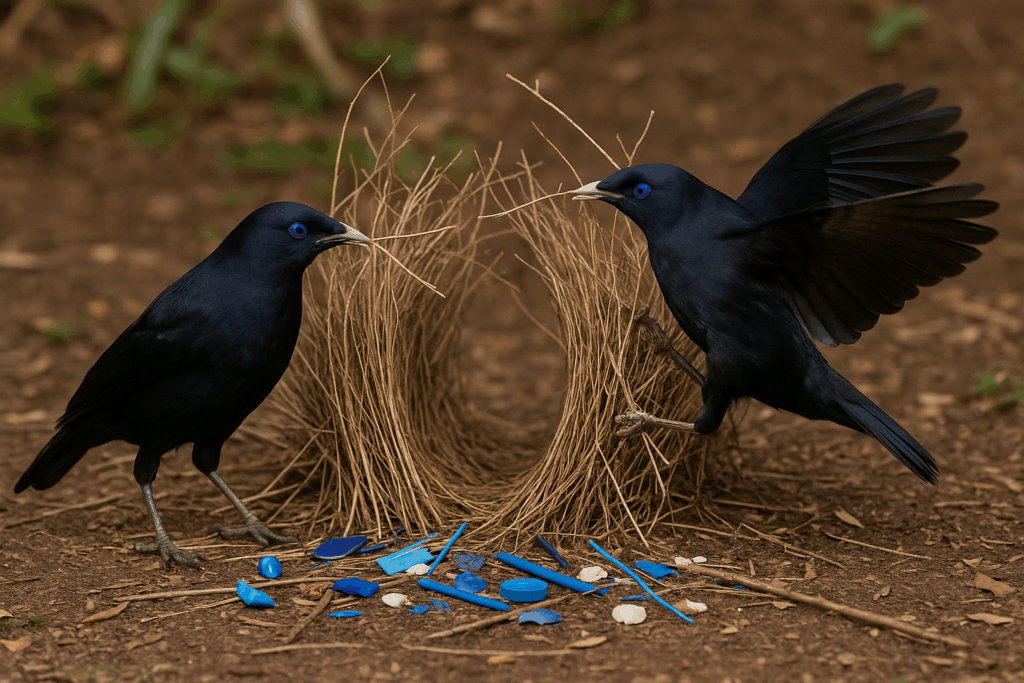How to Ruin Your Neighbor’s Love Life and Still Be Considered a Gentleman.

Imagine you’ve spent weeks perfecting your bachelor pad. The throw pillows are fluffed just right. You’ve arranged your vintage record collection by color. There’s a suspiciously large number of blue objects scattered artfully around the room because you read somewhere that women find blue attractive. You’re finally ready for that big date.
Then your neighbor kicks down your door, steals your best decorations, knocks over your furniture, and leaves.
Welcome to the dating scene if you’re a male bowerbird.
The Ultimate Bachelor Pad Competition
Bowerbirds, found primarily in Australia and New Guinea, have turned courtship into an extreme home makeover show crossed with The Bachelor.
Male bowerbirds don’t just sing a pretty song or flash some colorful feathers (though they do that too). No, these overachievers build elaborate structures called bowers, essentially architectural displays designed for one purpose: impressing the ladies.
The satin bowerbird, in particular, constructs two parallel walls of sticks with an avenue between them. This isn’t a nest where eggs will be laid; think of it more as a nightclub VIP section. The female visits, checks out the venue, and if she’s impressed enough, mating happens right there in the avenue. Then she leaves to build her actual nest elsewhere, because apparently, this guy’s interior design skills don’t extend to family planning.
But these males don’t just build bowers, they decorate them with an obsessive attention to detail that would make Marie Kondo nervous.
The Magpie Complex (But Make It Fashion)
Satin bowerbirds have a thing for blue. Not just any blue objects, but specifically high-quality blue items: feathers, flowers, berries, and increasingly, human garbage. Bottle caps, straws, clothes pegs: if it’s blue and you dropped it in Australia, there’s a decent chance it’s now part of some bird’s elaborate mating display.
Scientists have discovered that it’s not just about quantity. A bower decorated with 200 blue bottle caps won’t necessarily beat one with 50 blue feathers and some yellow leaves. Quality matters.
The rare items like blue parrot feathers, yellow leaves, and snail shells are the Rolexes of the bowerbird decoration world. They signal that this dude has the time, energy, and survival skills to hunt down scarce resources.
The human trash, while colorful, is essentially fast fashion in the bowerbird economy. Easy to find, unimpressive, and unlikely to seal the deal.
Enter the Saboteurs
Now we arrive at the juicy part. Male bowerbirds form what’s called a lek: essentially a neighborhood where multiple males set up their bowers within visiting distance of each other. This allows females to bower-shop, comparing options before making their choice.
It also creates the perfect environment for industrial espionage.
Male bowerbirds are ruthless saboteurs. While one dude is off foraging for decorations or taking a break, his neighbors will raid his bower. They’ll steal the best decorations, particularly those coveted blue feathers and yellow leaves, and sometimes destroy the entire structure just for good measure.
This isn’t random vandalism. It’s calculated economic warfare. Research has shown that in bowerbird leks, a small number of high-quality guys secure the vast majority of mating opportunities. The competition is winner-takes-all, or more accurately, winner-takes-most-of-the-damsels.
The stakes are extraordinarily high. These dudes invest zero resources in raising offspring, no food, no protection, no childcare. They’re purely genetic donors. So from a lady’s perspective, the bower quality is the only tangible thing she has to evaluate. A well-decorated, well-maintained bower signals a guy with energy, resourcefulness, and the ability to defend his territory. Good genes, in other words.
The Time Tax
The sabotage strategy is surprisingly effective because of the time investment required. It takes enormous effort for a dude to collect quality decorations. Blue parrot feathers don’t just fall from the sky (well, technically they do, but rarely). Yellow leaves need to be found at the right stage of color change. Snail shells need to be, well, found.
But defending your bower from rival guys? That’s a full-time job. And if you’re spending all your time guarding your property, you’re not out collecting new decorations. It’s a zero-sum game, and the saboteurs have figured out how to exploit it.
Even better, by destroying a rival’s bower, you’re not just setting him back, you’re potentially stealing decorations that immediately upgrade your own display. It’s like robbing your competitor’s store and then selling their inventory at your own shop across the street.
The Damsel Perspective
Before we paint these dudes as complete villains, let’s consider what the damsels are evaluating. When a lady bowerbird visits a lek, she’s not just looking at decorations. She’s watching how the guys behave, how they move, and yes, how they handle the chaos of bower maintenance.
Some damsels will even test dudes by deliberately disrupting their displays to see how quickly and effectively they can recover. It’s a stress test. Can this dude handle adversity? Can he rebuild? Does he have the resilience needed to survive in a competitive world?
In this context, the sabotage isn’t just accepted: it’s part of the evaluation process. A guy who can maintain a quality bower despite constant raids from rivals is demonstrating exactly the kind of vigorous competence that makes for good genetic material.
The Evolutionary Arms Race
The bowerbird system reveals something fascinating about sexual selection and the absurd lengths animals will go to for reproductive success. These birds have evolved a culture of architectural warfare, where the battlefield is decorated with blue plastic and the weapons are theft and property destruction.
And they get away with it because, in the cruel logic of evolution, it works. The saboteurs who can maintain their own bowers while disrupting others’ displays gain a competitive advantage. The dudes with the best bowers earned through either superior collecting skills or successful sabotage pass on their genes.
The ladies, meanwhile, get to mate with guys who’ve proven they can thrive in a hostile, competitive environment. Everyone wins, except maybe Ben, whose bower Ron just destroyed.
When you’re frustrated with your own competitive dating market, remember: at least your romantic rivals aren’t literally breaking into your home and stealing your furniture while you’re at work.
Unless you’re a bowerbird. In which case, you might want to invest in better security.
The satin bowerbird’s strategy of sabotage isn’t just successful, it’s been refined over millions of years of evolution. These birds have turned home invasion into foreplay, theft into courtship strategy, and vandalism into a legitimate path to reproductive success.
Nature, it turns out, doesn’t always reward playing nice. Sometimes it rewards the bird who knows exactly when to crash someone else’s date, and has the blue feathers to prove he got away with it.
Nature’s Best Actor: The Killdeer Bird That Fakes Death to Fool Predators
Why Sloths Risk Their Lives to Poop Once a Week: Sloth Bathroom Facts
The fascinating research on bowerbird behavior comes from decades of field studies, particularly the work of Dr. Gerald Borgia at the University of Maryland, whose research has documented the complex dynamics of bower decoration, theft, and mating success in these remarkable birds.





